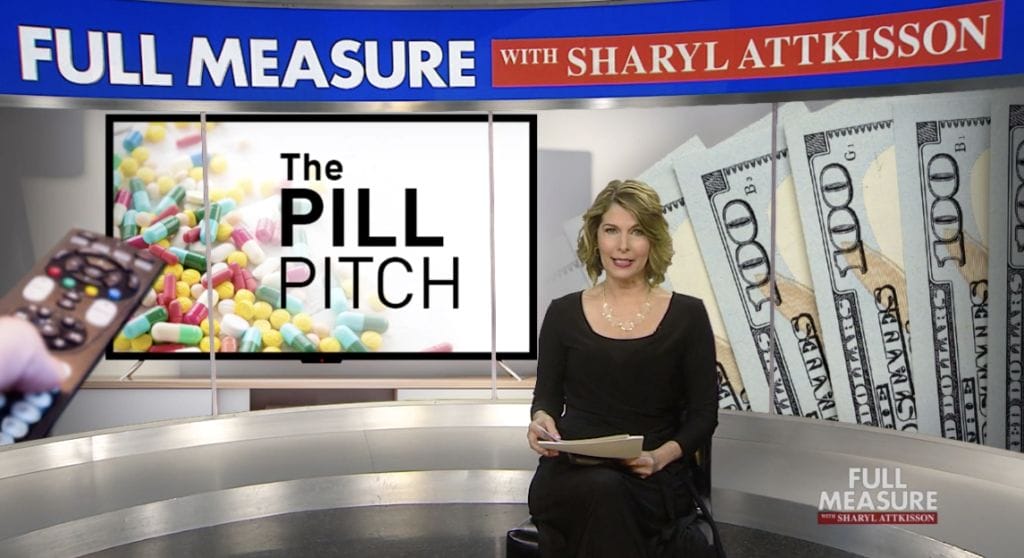
Prescription drugs help many people and even save lives. But use of prescription drugs as prescribed is also a leading cause of death in the U.S.
Are some pharmaceutical companies skirting TV ad rules so that they don’t have to disclose side effects of some vaccines and other prescription medicine?
Some critics say “yes.” And when I asked the FDA about the allegations, the agency told me it’s planning a new study into the issue.
Below are excerpts from my Full Measure investigation with a link to the full story at the bottom.
Full Measure has learned the FDA is planning a new study on TV advertising of prescription drugs. It’s a multi-billion dollar industry benefiting both pharmaceutical companies and the television networks paid to run the ads. Supporters say patients benefit too. But almost nowhere in the world is it allowed except here. And with prescription drugs a leading cause of death and injury, we investigate the Pill Pitch.
Dr. Michael Carome leads the Health Research Group at the watchdog Public Citizen.
He’s against prescription drug advertising on TV. It was forbidden until a fierce lobbying campaign by the pharmaceutical industry in the 1990s.
Dr. Michael Carome: In 1997, the FDA opened the floodgates to broadcast media: television, and radio ads, for prescription drugs, and we now have companies spending billions of dollars every year on this advertising.
Dr. Michael Carome: The average person in the US sees 9 drug ads a day, or 30 hours of drug ads per year. It’s just an extraordinary amount of exposure to prescription drug advertising.
The average person in the U.S. sees 9 drugs ads a day or 30 hours of drug ads per year.
Dr. Michael Carome, Public Citizen health group
The ads upset the longstanding rule that doctors alone should decide the best pills for patients.
To get an idea of how much the ads boost profits, you need only look at how much is spent on them. In 2018, the pharmaceutical industry shelled out $6.4 billion on so-called “direct-to-consumer ads.” No-one from the drug industry would agree to an interview. Representatives have said in the past that advertising saves lives and improves public health.
- In 2018, the pharmaceutical industry funded $6.4 billion on “direct-to-consumer ads.”
Dr. Carome say there are serious downsides.
Dr. Michael Carome: they’re newest drugs, so we often know the least about their safety because they haven’t been on the market for a while. And often there are older alternatives that may be equally effective, and safer, and because those drugs aren’t advertised, because the generic drug industry doesn’t do this type of advertising, it can worsen the public health overall.
Experts say taking prescription drugs as prescribed is a leading cause of death in the US – a factor in as many as 200,000 deaths a year.
Safety is a big reason why the FDA requires the ads to clearly disclose risks.
Dr. Michael Carome: they’re going to make sure that the viewers leave the commercial with an understanding of the benefits of perhaps some miracle cure, and not hopefully remember too much about the potential harms and risks.
Read more and watch our investigative report by clicking the link below:
https://fullmeasure.news/news/cover-story/the-pill-pitch

Thanks to the thousands who have already supported!




I’m so glad Sharyl covered this story. I have been against direct-to-consumer ads by pharma since it started under Bill Clinton’s administration when he sold out to big pharma.
Prior to that time, pharma could advertise their products ONLY in professional publications of the medical profession.
Restoring our policy to previous is a no-brainer, but pharma and the media won’t allow it.
This is true. Greedy media won’t surrender those mega-buck ad revenues and the pharma lobby way too strong.
It’s all about the money, isn’t it. Patient health and adverse impacts on the cost of healthcare be damned. Aren’t we the only country that allows direct-to-consumer television (or any media) ads? Here’s another thing. Have you ever noticed when the ads are most prevalent and on which stations? I have a habit of turning on MeTV for some mindless listening of old TV shows when I’m cooking dinner — after a day writing and listening to classical music, the break is needed. There are three types of ads that appear at that time on that channel and other similar ones: prescription drugs, class action lawsuit alerts, and other ads catering to needs of senior citizens, such as devices that Medicare will cover. So you can learn about a drug to get your doctor to prescribe, then find out about its adverse affects and consequently join a class action. It’s insane. Certainly not surprising, however, given the strength of our lobbyists and corruption of our politicos.
This covers but the skin depth of water over the deepest ocean, but it is a good start. Read Anatomy of an Epidemic by Whitaker, then go ahead and read the rebuttal by E Fuller Torrey who wrote the book on schizophrenia, that I yet to experience a single psychiatrist who follows although many refer to him. He rebuts some things that have been since proven not accurate in Whitakers book, but the main premise is supported “The leadership of the Psychiatric Industry including government entities has prostituted itself to the Pharmaceutical Industry”. Just ask Dr. Peter Breggin who has helped countless people get off this poison. If you want a more technical and deeper insight into the medical side read Dr. Moncrieff “The myth of a Chemical Cure”. The pharmaceutical industry controls mental health in this country and many others and has zero interest in curing anything, they make too much money helping people manage their illness. Curing people is one of those crises that the pharmaceutical must avoid at all cost, their industry depends on it. Case in point, Did you know there was a cure for hay fever that if taken for six weeks you would never have hay fever again? Made by an American pharmaceutical company, problem is it was only sold in Europe. When an American citizen traveling Europe was told by a doctor how to cure hay fever and he eventually followed his advice he was cured, that’s over twenty years ago. He discovered the U.S. version was missing one ingredient. When the company was confronted they ignored it, while at the same time pulled all of Europe’s products. Guess what there is no longer a marketed cure for hay fever. But that is very minor compared to what they are doing in the psychiatric industry to children and adults leaving them a lifetime of suffering and eventual death at the hands of theses drugs. Do they help short term, sometimes, long term they are devastating. I’ve watched it for over 30 years first hand with my beloved wife.